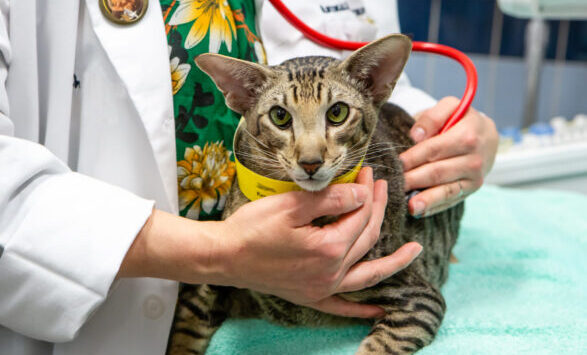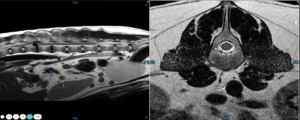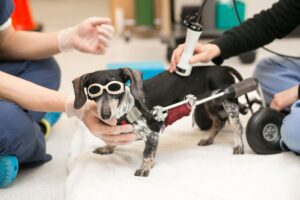Intervertebral Disc Disease (IVDD) in Dogs
Background
Intervertebral disc disease (IVDD) is one of the most common spinal conditions in dogs and is especially prevalent in dogs with a long back and short legs.
Your dog’s spinal column is made up of a series of backbones (vertebrae) with disc-shaped cushions between them. These cushions, which are known as intervertebral discs, act as shock absorbers for the spine and also provide stability.
Each cushioning disc has a thick covering on the outside, with a softer, gel-like core. Over time, the outer portion of the disc breaks down while the inner portion hardens. If the outer portion breaks down too much, the hardened interior can bulge or burst into the spinal canal and put pressure on the spinal cord or nerves as they branch off the spinal cord. This is commonly referred to as a herniated disc or slipped disc, and it can cause a wobbly walk, back or neck pain, nerve damage, and even hind limb paralysis.
Generally speaking, there are two types of IVDD:
- Type I primarily affects young to middle-aged dogs. It occurs mainly in chondrodystrophic breeds, which are the dogs with the long back and short legs. In these dogs, breakdown of the disc (or discs) tends to begin early in life, leaving the disc vulnerable to damage from activities that usually would be considered normal. If an at-risk dog jumps off a couch or takes a sharp turn while chasing a ball, the hardened disc may bulge against the spinal cord causing sudden pain or gait changes.
- Type II primarily affects older large breed dogs such as Labrador retrievers and German shepherds, and signs tend to appear more gradually. In type II IVDD, breakdown of the disc causes it to bulge into the spinal canal over a period of weeks or months causing slow and gradual loss of the ability to walk normally.
IVDD can occur anywhere in the spine but is most common in the middle of it (between the shoulders and hips) or in the neck. When it occurs in the middle of the spine, only the hindlimbs are affected while all four limbs may be affected if the problem exists in the neck.

Risk Factors
IVDD can occur in any type of dog, but it is most common in the following breeds:
- Basset hounds
- Beagles
- French bulldogs
- Cocker spaniels
- Corgis
- Dachshunds
- German shepherds
- Labrador retrievers
- Lhasa apsos
- Pekingese
- Shih tzus
Signs
Signs vary depending on the location of the disc and the severity of the injury, but may include:
- Swaying or wobbly walk
- Scuffing of the nails
- Weakness
- Pain
- Reluctance to jump up or go down stairs
- Loss of bladder or bowel control
- Paralysis
Diagnosis
IVDD can progress quickly, so it’s important to have your dog seen by a veterinarian as soon as you suspect there may a problem. Until your dog can be examined, it’s best to confine him to a small area or crate to prevent further injury.
If your dog can’t walk, this is an emergency, and you should bring your dog to your veterinarian or a veterinary ER immediately. Prompt treatment results in a better chance for your dog to walk again.
At the Animal Medical Center, board certified veterinary neurologists use magnetic resonance imaging (MRI) to diagnose IVDD, which requires general anesthesia. If IVDD Is diagnosed, your dog will be operated on immediately to remove the extruded disc material.
Treatment
Treatments include both medication therapy and surgery. Your veterinarian may refer you to a specialist to help you decide which course of treatment is best for your dog.
Medication and Strict Rest
In less severe cases, dogs may benefit from anti-inflammatory medication to reduce swelling in the spinal cord, or nerve pain medication to relieve discomfort while the spinal cord heals. Crate rest and minimal movement for up to six weeks is usually necessary.
Surgery
In more severe cases of IVDD, surgery may be recommended to remove the extruded disc material pressing on the spinal cord and nerves. After the surgery, crate rest is recommended for 4-6 weeks. Some dogs do not recover bladder function immediately and you will need to learn to manually express your dog’s bladder until normal bladder function returns.
After a 4-week rest period, either post-surgery or following treatment with medication, physical rehabilitation can help your dog recover more fully and achieve maximum function of their limbs. Methods such as laser therapy (below), hydrotherapy, and acupuncture are just a few of the tools that can help get your pup back on their feet. Your rehabilitation specialist will design a program tailored to your dog’s needs.
Prevention
Regular exercise is very important to intervertebral disc health. Daily 20- to 30-minute walks, on a level surface are ideal for keeping your dog’s back healthy. Because discs are the shock absorbers of the spine, at-risk dogs should not be allowed to run on stairs or jump from furniture or high places. Doggie steps or ramps are recommended to help these dogs get on and off furniture safely. Regular exercise also promotes weight control, which is vital to keeping stress off the joints of the back and limbs. Feeding a balanced diet with antioxidants will help keep the discs healthy.
Despite these efforts, IVDD may still occur. In that instance, discontinuing all physical activity and seeking veterinary care is the best course of action.
Make an Appointment

Neurology
AMC's Neurology team is led by three board-certified Neurologists with more than 30 years of combined experience in treating conditions of the spinal cord, brain, muscle, and nerve tissue in pets.
Learn More

































